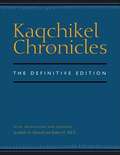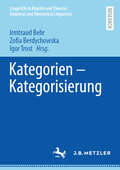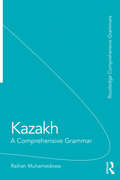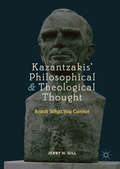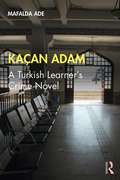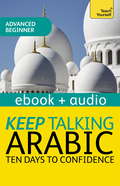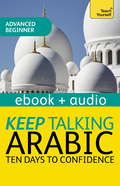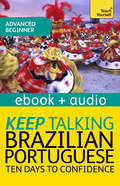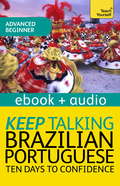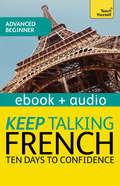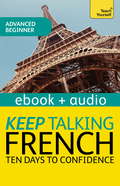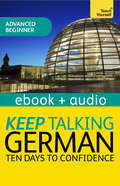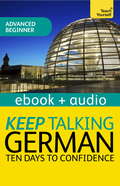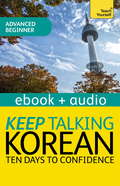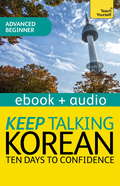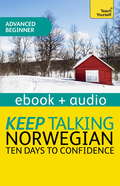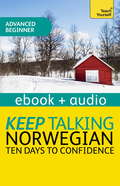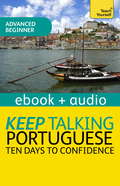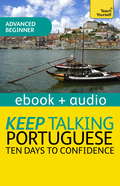- Table View
- List View
Kaqchikel Chronicles: The Definitive Edition
by Judith M. Maxwell Robert M. Hill IIThe collection of documents known as the Kaqchikel Chronicles consists of rare highland Maya texts, which trace Kaqchikel Maya history from their legendary departure from Tollan/Tula through their migrations, wars, the Spanish invasion, and the first century of Spanish colonial rule. The texts represent a variety of genres, including formal narrative, continuous year-count annals, contribution records, genealogies, and land disputes. While the Kaqchikel Chronicles have been known to scholars for many years, this volume is the first and only translation of the texts in their entirety. The book includes two collections of documents, one known as the Annals of the Kaqchikels and the other as the Xpantzay Cartulary. The translation has been prepared by leading Mesoamericanists in collaboration with Kaqchikel-speaking linguistic scholars. It features interlinear glossing, which allows readers to follow the translators in the process of rendering colonial Kaqchikel into modern English. Extensive footnoting within the text restores the depth and texture of cultural context to the Chronicles. To put the translations in context, Judith Maxwell and Robert Hill have written a full scholarly introduction that provides the first modern linguistic discussion of the phonological, morphological, syntactic, and pragmatic structure of sixteenth-century Kaqchikel. The translators also tell a lively story of how these texts, which derive from pre-contact indigenous pictographic and cartographic histories, came to be converted into their present form.
Kategorien – Kategorisierung (Linguistik in Empirie und Theorie/Empirical and Theoretical Linguistics)
by Igor Trost Irmtraud Behr Zofia BerdychowskaDer Band Kategorien – Kategorisierung ist die erste Abhandlung, die Überlegungen zum Aufbau verschiedener Kategoriengefüge mit kategorialen Zugriffen auf neue Objekte verbindet und dabei neben grammatischen Kategorien auch semantische Rollen, Perspektivierung und Situationskategorisierungen untersucht. Die Prinzipien der Kategorienbildung werden wissenschaftshistorisch und als Bestandteile von Theorien betrachtet, Begriffe wie Relation, Binaritätsprinzip und Skaralität kennzeichnen den Aufbau der Kategoriensysteme, während kategoriale Homonymie die Ausdrucksseite und Kategorialrahmen den Skopus der Kategorien erfasst. Ein vergleichsweise neues Gebiet der Kategorienforschung wird erschlossen mit dem Komplex von Perspektivierung, semantische Rollen und Situationskategorisierung.
Kazakh: A Comprehensive Grammar (Turcologica Ser. #102)
by Raikhangul MukhamedovaKazakh: A Comprehensive Grammar is the first thorough analysis of Kazakh to be published in English. The volume is systematically organized to enable users to find information quickly and easily, and provides a thorough understanding of Kazakh grammar, with special emphasis given to syntax. Features of this book include: descriptions of phonology, morphology and syntax; examples from contemporary usage; tables summarizing discussions, for reference; a bibliography of works relating to Kazakh. Kazakh: A Comprehensive Grammar reflects the richness of the language, focusing on spoken and written varieties in post-Soviet Kazakhstan. It is an essential purchase for all linguists and scholars interested in Kazakh or in Turkic languages as well as advanced learners of Kazakh.
Kazantzakis’ Philosophical and Theological Thought: Reach What You Cannot
by Jerry H. GillThis book explores the philosophical and theological thought of Nikos Kazantzakis. Kazantzakis is a well-known and highly influential Greek writer, having authored such works as Zorba the Greek and The Last Temptation of Christ, among many others. This volume focuses on the over-arching themes of Kazantzakis’ work, namely the importance of the natural world, the nature of humanity, and the nature of God, by means of an analysis of his major novels and other writings. Along the way attention is given to the views of the important scholars who have interacted with Kazantzakis’s works, including Peter Bien, Darren Middleton, and Daniel Dombrowski.
Kaçan Adam: A Turkish Learner’s Crime Novel
by Mafalda AdeAimed at intermediate Turkish learners, Kaçan Adam: A Turkish Learner’s Crime Novel is a short mystery / detective story in idiomatic Turkish complete with exercises, vocabulary and grammar review. Over the course of 24 lively chapters, it follows the fate of former intelligence officer Erkan Demirel, who has been convicted of selling secret military documents but who manages to escape from prison and embarks on a quest to prove his innocence… For use either as a supplement to classroom instruction (CEFR A2-B1 and ACTFL, Lower Intermediate Level) or individually, this book will guide students through their first complete novel in Turkish while revising and reinforcing key points of modern Turkish grammar and expression.
Keep Talking Arabic Audio Course - Ten Days to Confidence: Advanced beginner's guide to speaking and understanding with confidence
by Jane Wightwick Mahmoud GaafarIf you already have the basics and want to learn more Arabic, this advanced beginner audio course will boost your confidence to understand and speak Arabic.Practise the most frequent words and expressions for:-explaining where you are from-explaining what you do-asking about sightseeing-talking about hobbies-describing family photos-giving compliments and congratulating-describing your trip-talking about holiday activities-talking about what you enjoyed-offering help.You'll progress in your understanding by working out language patterns for yourself, personalize your Arabic with interactive role-plays and perfect your pronunciation to sound more natural.Keep Talking Arabic - Ten Days to Confidence maps to A1 of the Common European Framework of Reference (CEFR) for languages.Rely on Teach Yourself, trusted by language learners for over 75 years.
Keep Talking Arabic Audio Course - Ten Days to Confidence: Enhanced Edition
by Jane Wightwick Mahmoud GaafarIf you already have the basics and want to learn more Arabic, this advanced beginner audio course will boost your confidence to understand and speak Arabic.Practise the most frequent words and expressions for:-explaining where you are from-explaining what you do-asking about sightseeing-talking about hobbies-describing family photos-giving compliments and congratulating-describing your trip-talking about holiday activities-talking about what you enjoyed-offering help.You'll progress in your understanding by working out language patterns for yourself, personalize your Arabic with interactive role-plays and perfect your pronunciation to sound more natural.Also included is a handy phrasebook and a PDF coursebook for reading and writing practice.Keep Talking Arabic - Ten Days to Confidence maps to A1 of the Common European Framework of Reference (CEFR) for languages.Rely on Teach Yourself, trusted by language learners for over 75 years.
Keep Talking Brazilian Portuguese Audio Course - Ten Days to Confidence: Enhanced Edition
by Sue Tyson-Ward Ethel Pereira RowbothamIf you already have the basics and want to learn more Brazilian Portuguese, this advanced beginner audio course will boost your confidence to understand and speak Brazilian Portuguese.Practise the most frequent words and expressions for:-staying at a hotel-meeting people-talking about sports and hobbies-shopping at the market-talking on the phone-going to a restaurant-shopping for clothes-going out for the evening-reporting a theft-booking an excursion.You'll progress in your understanding by working out language patterns for yourself, personalize your Brazilian Portuguese with interactive role-plays and perfect your pronunciation to sound more natural.This advanced beginner Brazilian Portuguese course contains an MP3 CD. You can download the audio files on this disc from your computer to your MP3 player or play it in an MP3 CD player. Also included is a handy phrasebook and a PDF coursebook for reading and writing practice.Keep Talking Brazilian Portuguese - Ten Days to Confidence maps to A1 of the Common European Framework of Reference (CEFR) for languages.Rely on Teach Yourself, trusted by language learners for over 75 years.
Keep Talking Brazilian Portuguese Audio Course - Ten Days to Confidence: Enhanced Edition
by Sue Tyson-Ward Ethel Pereira RowbothamIf you already have the basics and want to learn more Brazilian Portuguese, this advanced beginner audio course will boost your confidence to understand and speak Brazilian Portuguese.Practise the most frequent words and expressions for:-staying at a hotel-meeting people-talking about sports and hobbies-shopping at the market-talking on the phone-going to a restaurant-shopping for clothes-going out for the evening-reporting a theft-booking an excursion.You'll progress in your understanding by working out language patterns for yourself, personalize your Brazilian Portuguese with interactive role-plays and perfect your pronunciation to sound more natural.Keep Talking Brazilian Portuguese - Ten Days to Confidence maps to A1 of the Common European Framework of Reference (CEFR) for languages.Rely on Teach Yourself, trusted by language learners for over 75 years.
Keep Talking Dutch Audio Course - Ten Days to Confidence: Audio eBook
by Marleen OwenIf you already have the basics and want to learn more Dutch, this advanced beginner audio course will boost your confidence to understand and speak Dutch.Practise the most frequent words and expressions for:-booking a room-booking a restaurant-visiting a museum-going on a canal trip-ordering an Indonesian meal-talking about Dutch food-getting directions to the museum-finding out where the Stopera is-talking about learning Dutch-talking about work.You'll progress in your understanding by working out language patterns for yourself, personalise your Dutch with interactive role-plays and perfect your pronunciation to sound more natural.Keep Talking Dutch - Ten Days to Confidence maps to A1 of the Common European Framework of Reference (CEFR) for languages.Rely on Teach Yourself, trusted by language learners for over 75 years.
Keep Talking Dutch Audio Course - Ten Days to Confidence: Audio eBook
by Marleen OwenIf you already have the basics and want to learn more Dutch, this advanced beginner audio course will boost your confidence to understand and speak Dutch.Practise the most frequent words and expressions for:-booking a room-booking a restaurant-visiting a museum-going on a canal trip-ordering an Indonesian meal-talking about Dutch food-getting directions to the museum-finding out where the Stopera is-talking about learning Dutch-talking about work.You'll progress in your understanding by working out language patterns for yourself, personalise your Dutch with interactive role-plays and perfect your pronunciation to sound more natural.Keep Talking Dutch - Ten Days to Confidence maps to A1 of the Common European Framework of Reference (CEFR) for languages.Rely on Teach Yourself, trusted by language learners for over 75 years.
Keep Talking French Audio Course - Ten Days to Confidence: Enhanced Edition
by Jean-Claude ArragonIf you already have the basics and want to learn more French, this advanced beginner audio-based course will boost your confidence to speak and understand.Practise the most frequent words and expressions for:-completing a questionnaire-staying at a hotel-going out for dinner and drinks-dealing with an emergency-giving directions-being welcomed by an old friend-having dinner at a friend’s house-going wine-tasting-shopping at a market-taking public transport.You'll progress in your understanding by working out language patterns for yourself, personalise your French with interactive role-plays and perfect your pronunciation to sound more natural.Rely on Teach Yourself, trusted by language learners for over 70 years
Keep Talking French Audio Course - Ten Days to Confidence: Enhanced Edition
by Jean-Claude ArragonIf you already have the basics and want to learn more French, this advanced beginner audio-based course will boost your confidence to speak and understand.Practise the most frequent words and expressions for:-completing a questionnaire-staying at a hotel-going out for dinner and drinks-dealing with an emergency-giving directions-being welcomed by an old friend-having dinner at a friend’s house-going wine-tasting-shopping at a market-taking public transport.You'll progress in your understanding by working out language patterns for yourself, personalise your French with interactive role-plays and perfect your pronunciation to sound more natural.Rely on Teach Yourself, trusted by language learners for over 70 years
Keep Talking German Audio Course - Ten Days to Confidence: Enhanced Edition
by Paul Coggle Heiner SchenkeIf you already have the basics and want to learn more German, this advanced beginner audio course will boost your confidence to understand and speak German.Practise the most frequent words and expressions for: -renting a car -booking a hotel room -meeting at a party -ordering starters and drinks -ordering a main course and a dessert -talking about yourself and your family -talking about likes and dislikes -travelling about town -making arrangements -talking about a weekend break.You'll progress in your understanding by working out language patterns for yourself, personalize your German with interactive role-plays and perfect your pronunciation to sound more natural.This advanced beginner German course contains an MP3 CD. You can download the audio files on this disc from your computer to your MP3 player or play it in an MP3 CD player. Also included is a handy phrasebook and a PDF coursebook for reading and writing practice.Keep Talking German - Ten Days to Confidence maps to A1 of the Common European Framework of Reference (CEFR) for languages.Rely on Teach Yourself, trusted by language learners for over 75 years.
Keep Talking German Audio Course - Ten Days to Confidence: Enhanced Edition
by Paul Coggle Heiner SchenkeIf you already have the basics and want to learn more German, this advanced beginner audio course will boost your confidence to understand and speak German.Practise the most frequent words and expressions for: -renting a car -booking a hotel room -meeting at a party -ordering starters and drinks -ordering a main course and a dessert -talking about yourself and your family -talking about likes and dislikes -travelling about town -making arrangements -talking about a weekend break.You'll progress in your understanding by working out language patterns for yourself, personalize your German with interactive role-plays and perfect your pronunciation to sound more natural.This advanced beginner German course contains an MP3 CD. You can download the audio files on this disc from your computer to your MP3 player or play it in an MP3 CD player. Also included is a handy phrasebook and a PDF coursebook for reading and writing practice.Keep Talking German - Ten Days to Confidence maps to A1 of the Common European Framework of Reference (CEFR) for languages.Rely on Teach Yourself, trusted by language learners for over 75 years.
Keep Talking Italian Audio Course - Ten Days to Confidence: Enhanced Edition
by Federica Sturani Maria GuarnieriIf you already have the basics and want to learn more Italian, this advanced beginner audio course will boost your confidence to understand and speak Italian.Practise the most frequent words and expressions for:-getting a train-asking for directions-booking a table-having a meal-going to the market-going wine tasting-going to a local festival-making friends-finding out more-talking about your holiday.You'll progress in your understanding by working out language patterns for yourself, personalize your Italian with interactive role-plays and perfect your pronunciation to sound more natural.Keep Talking Italian - Ten Days to Confidence maps to A1 of the Common European Framework of Reference (CEFR) for languages.Rely on Teach Yourself, trusted by language learners for over 75 years.
Keep Talking Italian Audio Course - Ten Days to Confidence: Enhanced Edition
by Federica Sturani Maria GuarnieriIf you already have the basics and want to learn more Italian, this advanced beginner audio course will boost your confidence to understand and speak Italian.Practise the most frequent words and expressions for:-getting a train-asking for directions-booking a table-having a meal-going to the market-going wine tasting-going to a local festival-making friends-finding out more-talking about your holiday.You'll progress in your understanding by working out language patterns for yourself, personalize your Italian with interactive role-plays and perfect your pronunciation to sound more natural.Keep Talking Italian - Ten Days to Confidence maps to A1 of the Common European Framework of Reference (CEFR) for languages.Rely on Teach Yourself, trusted by language learners for over 75 years.
Keep Talking Japanese Audio Course - Ten Days to Confidence: Enhanced Edition
by Helen GilhoolyIf you already have the basics and want to learn more Japanese, this advanced beginner audio course will boost your confidence to understand and speak Japanese.Practise the most frequent words and expressions for:-making business introductions-having formal conversations-staying in a Japanese inn-eating in a Japanese restaurant-visiting a fish market-talking about your daily routine-discussing the weather-talking about past events-giving permission-making a thank you speech.You'll progress in your understanding by working out language patterns for yourself, personalise your Japanese with interactive role-plays and perfect your pronunciation to sound more natural.Keep Talking Japanese - Ten Days to Confidence maps to A1 of the Common European Framework of Reference (CEFR) for languages.Rely on Teach Yourself, trusted by language learners for over 75 years.
Keep Talking Japanese Audio Course - Ten Days to Confidence: Enhanced Edition
by Helen GilhoolyIf you already have the basics and want to learn more Japanese, this advanced beginner audio course will boost your confidence to understand and speak Japanese.Practise the most frequent words and expressions for:-making business introductions-having formal conversations-staying in a Japanese inn-eating in a Japanese restaurant-visiting a fish market-talking about your daily routine-discussing the weather-talking about past events-giving permission-making a thank you speech.You'll progress in your understanding by working out language patterns for yourself, personalise your Japanese with interactive role-plays and perfect your pronunciation to sound more natural.Keep Talking Japanese - Ten Days to Confidence maps to A1 of the Common European Framework of Reference (CEFR) for languages.Rely on Teach Yourself, trusted by language learners for over 75 years.
Keep Talking Korean Audio Course - Ten Days to Confidence: Enhanced Edition
by Robert Vernon Kyung-Il KwakWhen going abroad do you want to:- Communicate more accurately and precisely?- Get to places other travellers don't?- Do more than just 'get by'?- Have fun and more authentic experiences?...Then you need to Keep Talking!Through 10 common scenarios plus culture and travel advice this advanced beginner level audio course will get you beyond the basics. - Practise the most frequent words and expressions for common travel situations- Progress in your understanding of naturally paced conversations- Personalize the language with interactive role-plays- Perfect your pronunciation and sound more naturalYou'll progress in your understanding by working out language patterns for yourself, personalize your Korean with interactive role-plays and perfect your pronunciation to sound more natural.This advanced beginner Korean course contains an MP3 CD. You can download the audio files on this disc from your computer to your MP3 player or play it in an MP3 CD player. Also included is a handy phrasebook and a PDF coursebook for reading and writing practice.Keep Talking Korean - Ten Days to Confidence maps to A1 of the Common European Framework of Reference (CEFR) for languages.Rely on Teach Yourself, trusted by language learners for over 75 years.
Keep Talking Korean Audio Course - Ten Days to Confidence: Enhanced Edition
by Robert Vernon Kyung-Il KwakWhen going abroad do you want to:- Communicate more accurately and precisely?- Get to places other travellers don't?- Do more than just 'get by'?- Have fun and more authentic experiences?...Then you need to Keep Talking!Through 10 common scenarios plus culture and travel advice this advanced beginner level audio course will get you beyond the basics. - Practise the most frequent words and expressions for common travel situations- Progress in your understanding of naturally paced conversations- Personalize the language with interactive role-plays- Perfect your pronunciation and sound more naturalYou'll progress in your understanding by working out language patterns for yourself, personalize your Korean with interactive role-plays and perfect your pronunciation to sound more natural.This advanced beginner Korean course contains an MP3 CD. You can download the audio files on this disc from your computer to your MP3 player or play it in an MP3 CD player. Also included is a handy phrasebook and a PDF coursebook for reading and writing practice.Keep Talking Korean - Ten Days to Confidence maps to A1 of the Common European Framework of Reference (CEFR) for languages.Rely on Teach Yourself, trusted by language learners for over 75 years.
Keep Talking Norwegian Audio Course - Ten Days to Confidence: Enhanced Edition
by Margaretha Danbolt-SimonsIf you already have the basics and want to learn more Norwegian, this advanced beginner audio course will boost your confidence to understand and speak Norwegian.Practise the most frequent words and expressions for:-having an encounter on a plane-arranging to meet-going to the chemist's-meeting the family-sightseeing in Oslo-buying clothes-having lunch at a restaurant-asking for directions-buying a rail ticket-saying goodbye.You'll progress in your understanding by working out language patterns for yourself, personalise your Norwegian with interactive role-plays and perfect your pronunciation to sound more natural.Keep Talking Norwegian - Ten Days to Confidence maps to A1 of the Common European Framework of Reference (CEFR) for languages.Rely on Teach Yourself, trusted by language learners for over 75 years.
Keep Talking Norwegian Audio Course - Ten Days to Confidence: Enhanced Edition
by Margaretha Danbolt-SimonsIf you already have the basics and want to learn more Norwegian, this advanced beginner audio course will boost your confidence to understand and speak Norwegian.Practise the most frequent words and expressions for:-having an encounter on a plane-arranging to meet-going to the chemist's-meeting the family-sightseeing in Oslo-buying clothes-having lunch at a restaurant-asking for directions-buying a rail ticket-saying goodbye.You'll progress in your understanding by working out language patterns for yourself, personalise your Norwegian with interactive role-plays and perfect your pronunciation to sound more natural.Keep Talking Norwegian - Ten Days to Confidence maps to A1 of the Common European Framework of Reference (CEFR) for languages.Rely on Teach Yourself, trusted by language learners for over 75 years.
Keep Talking Portuguese Audio Course - Ten Days to Confidence: Enhanced Edition
by Sue Tyson-WardIf you already have the basics and want to learn more Portuguese, this advanced beginner audio course will boost your confidence to understand and speak Portuguese.Practise the most frequent words and expressions for:-getting to know people-booking a restaurant table-eating out-shopping for food-solving problems-catching a train-going out for the evening-asking for directions-being ill-shopping for clothes and shoes.You'll progress in your understanding by working out language patterns for yourself, personalise your Portuguese with interactive role-plays and perfect your pronunciation to sound more natural.Keep Talking Portuguese - Ten Days to Confidence maps to A1 of the Common European Framework of Reference (CEFR) for languages.Rely on Teach Yourself, trusted by language learners for over 75 years.
Keep Talking Portuguese Audio Course - Ten Days to Confidence: Enhanced Edition
by Sue Tyson-WardIf you already have the basics and want to learn more Portuguese, this advanced beginner audio course will boost your confidence to understand and speak Portuguese.Practise the most frequent words and expressions for:-getting to know people-booking a restaurant table-eating out-shopping for food-solving problems-catching a train-going out for the evening-asking for directions-being ill-shopping for clothes and shoes.You'll progress in your understanding by working out language patterns for yourself, personalise your Portuguese with interactive role-plays and perfect your pronunciation to sound more natural.Keep Talking Portuguese - Ten Days to Confidence maps to A1 of the Common European Framework of Reference (CEFR) for languages.Rely on Teach Yourself, trusted by language learners for over 75 years.
